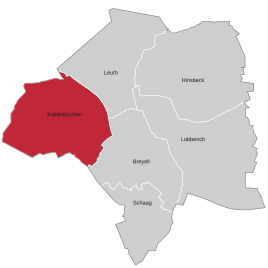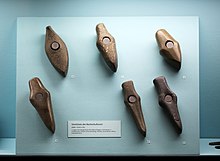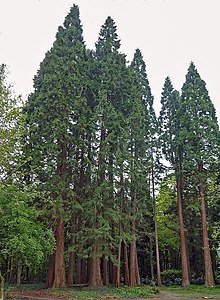Kaldenkirchen
|
Kaldenkirchen
City of Nettetal
|
|
|---|---|
| Coordinates: 51 ° 19 ′ 15 ″ N , 6 ° 11 ′ 58 ″ E | |
| Height : | 50 m |
| Area : | 15.24 km² |
| Residents : | 10,035 (Dec. 31, 2019) |
| Population density : | 658 inhabitants / km² |
| Incorporation : | January 1, 1970 |
| Postal code : | 41334 |
| Area code : | 02157 |
|
Location Kaldenkirchen in the city of Nettetal
|
|
Kaldenkirchen is a district of Nettetal in the Viersen district in North Rhine-Westphalia and is located directly on the German- Dutch border.
history
By 1814
The oldest document, in which the place name "Caldenkirken" is mentioned, bears the year 1206; it documents an agreement on the future marriage between Count Gerhard IV von Geldern and the Brabant duke's daughter Margaretha. The name probably goes back to the fact that the parish church in the village (first mentioned in 1276) was still "cold" at the time it was named, i.e. not completed.
In the early 14th century the place came under the rule of the counts and later dukes of Jülich ( Duchy of Jülich ), this phase ended with the invasion of French troops in 1794 ( French period until around 1815). From the year 1600 Kaldenkirchen took on town-like structures and was called a fortress. A mayor was mentioned for the first time in 1619.
Some Kaldenkircheners were also among the 13 German Quaker and Mennonite families who set out from Krefeld in 1683 and emigrated to Philadelphia on the ship " Concord " and settled there in the newly founded city of Germantown .
1814 until today
After the Congress of Vienna (1814/15) Kaldenkirchen belonged to Prussia; In 1819 the main customs office was established. From 1856 the place was allowed to designate itself as a city by decree of King Friedrich Wilhelm IV . In 1866 and 1868 the Venlo-Kaldenkirchen and Kempen-Kaldenkirchen railways were inaugurated. In 1903 Kaiser Wilhelm II approved the city arms.
During the Second World War , the Venlo-Herongen Air Base was north of Kaldenkirchen . From mid-1942 there were frequent attacks on the Kaldenkirchen train station . On the site of a former mill there was a camp for prisoners of war and forced laborers from occupied countries. In November 1944 the city was evacuated . A defensive position (" Maas-Rur position ") was built from Venlo to Wassenberg . On March 1, 1945, US troops first moved through Brüggen without a fight and then entered Kaldenkirchen around 3 p.m. the 784th Panzer Battalion continued to Venlo . In the summer of 1947, a fire almost completely destroyed the Kaldenkirchen border forest .
In 1961 Kaldenkirchen had 6,305 inhabitants, 23% of whom were displaced . On January 1, 1970, the city became part of the city of Nettetal, which was formed on the same day .
In 2011, work began on the Venete business park.
religion
The dominant Catholic parish church in the middle of the village , a three-aisled neo-Gothic hall structure, took over only the square west tower with sparse pointed arches from its late Gothic predecessor.
The church used to be not only a parish, but also a monastery church for two monasteries east of the church. Behind the facade romanisierenden rectory of 1844, the hides monk house of Brigittiner -Doppelklosters Maria fruit . The women's monastery was north of the church choir and has also been preserved in major parts of its building fabric.
A small Reformed church was formed. This denominational minority built a church in 1672 that is not visible from the street. It is hidden behind the rectory. A small inner courtyard is located between these buildings; a narrow corridor allows access from the city side. The church thus belongs to the type of court church. Today the congregation belongs to the Evangelical Church in the Rhineland .
In 1873 the Jewish community built a synagogue , which was desecrated in the November pogrom in 1938 . The current street name Synagogenstrasse and a memorial plaque on site are reminiscent of the building that was demolished around 1960.
Attractions
Catholic parish church of St Clement
Today's three-aisled neo-Gothic church hall was built from 1893 to 1897. It contains some parts from the previous church: the altarpiece by Hans von Aachen , a late Gothic cross from around 1500 and a brass font from 1793. The tower is 59 m high and was built in the late 15th century.
The evangelical court church
The court church of the small Reformed community , built in 1672, was shielded from the street by the school and rectory . Grave slabs (some in Dutch) are attached to the church wall.
Rococo Pavilion
In a garden close to the center there is a garden pavilion from the 18th century, a graceful recreational architecture of high artistic value. The pavilion became known nationwide through numerous paintings by August von Brandis, who lingered in it, at that time the property belonged to his brother-in-law.

Recreation and nature reserve Grenzwald
The Kaldenkirchen border forest in the nature reserve contains some nature reserves, the slope to the Maas called the gorge with a wide view of the Dutch lowlands, the Arboretum Sequoiafarm Kaldenkirchen and the geo-hydrological water garden
Altenhof Manor
The estate was mentioned as early as 1312 in a fief book of Duke Heinrich III. from Brabant . The estate remained in the possession of the Counts of Spee until it was sold in 1833 . Above the entrance gate is the alliance coat of arms with the cock of the von Spees and the gentlemen of Scheidt called Weschpfennig . Today the estate is an agricultural business owned by the Baum-Underberg family.
Birgitten Monastery
The monastery, also called Brigittenheim, was founded in 1625 and consisted of a women's and a men's monastery. It belonged to the order of St. Birgitta of Sweden . The male monastery, in which priest and lay monks used to live, is today's pastorate ; the women's monastery, which had a hidden entrance to the church, is currently used as a kindergarten.
Former main customs office
In 1818 Kaldenkirchen was given a main customs office because of its exposed location on the Prussian western border. The large two-storey plastered building was restored in the 1970s . Today it is used as a "community center".
Others
Further sights are the war memorial from 1913 (to commemorate the war of 1870/71 ), the Marienkapellchen (also called King's Chapel), first mentioned in 1775, and a building that served as the town hall from 1601 to 1898. In 2002 the Tolkemite memorial stone was erected; Around 600 refugees from Tolkemit found a new home in the city of Nettetal in 1946. The premium hiking trail "Galgenvenn" leads through the border forest . In 2016 it was voted the second most beautiful hiking trail in Germany.
Economy and Infrastructure
Economic history
Kaldenkirchen's economic life was shaped by the tobacco industry for over 150 years . In 1921 the city's tobacco and cigar factories employed 1217 people, about two thirds of the population working in Kaldenkirchen. Customs and tax policy changes then made this industry disappear entirely. Around 1900 a roof tile and clay pipe industry developed. This used clay deposits in the border forest and was able to distribute its products well thanks to the rail network that had been massively expanded in the decades before . After the Second World War, in the years of reconstruction , this industry flourished briefly.
In 1815, after the end of the French era , Kaldenkirchen became a border town on the western border of Prussia (to the Kingdom of the United Netherlands ). It became a transshipment point at which international freight forwarders had branches and where numerous customs officers were active. A main customs office was established. When the EC internal market was created in 1993 , the border became practically meaningless.
Several hundred seasonal workers are employed in agriculture during the asparagus season.
Well known beyond the city limits and very popular with young people and the young at heart is the "BaCa" station cafe, which has been located in the station building since the early 1980s. Until 2001 there was also a well-known club for the indie and alternative scene in the form of the Doppelpunkt disco.
Established businesses
The supraregional commercial enterprises that currently have their headquarters in Kaldenkirchen include the Lappen tree nursery, the German sales force for the hi-fi equipment manufacturer Denon, and Mekkafood, a Halāl product company. Westdeutsche wickfabrik GmbH & Co. KG, the world market leader for wicks, has both its production and administrative headquarters in Kaldenkirchen. Until 2010 the German representation of the Panini publishing house was here .
traffic
Rail and bus transport (as of December 2016)
The town's train station is on the Viersen – Venlo railway line and is served every hour by the Maas-Wupper-Express , a regional express of the Eurobahn to Venlo or in the direction of Viersen , Mönchengladbach , Düsseldorf , Hagen and Hamm .
In Kaldenkirchen, the SWK Mobil bus line 074 runs to Brüggen, Viersen and Süchteln, as well as two DB Rheinlandbus lines : 093 to Lobberich and Kempen and 095 to Lobberich. In Kaldenkirchen these lines meet at the stops Am Schwimmbad and Markt . Since December 11, 2016, the border town has also been serving line 1 of the Venlo city service , which is operated by Arriva Personenvervoer Nederland (Limburg department), from Kaldenkirchen via Tegelen and Venlo station to Blerick.
In addition, a small train ran to Brüggen until 2000 ; passenger traffic had already been stopped in 1920.
Road traffic
Kaldenkirchen is south of Autobahn 61 ; there are three motorway junctions. Also on federal road 221 , which runs from north to south; 15 km north of Niederkrüchten ( A 52 , junction 3) and 9 km south of the A 40 (junction 2 Herongen). In April 2012 the A 61 became the Dutch A 74 / A 73 .
education
The following schools are located in Kaldenkirchen:
- Municipal secondary school in Nettetal
- Community secondary school Kaldenkirchen
- Kaldenkirchen Community Primary School
- Catholic primary school Kaldenkirchen
Personalities
sons and daughters of the town
- Carl Falck (1884–1947), administrative lawyer
- Lambert Maaßen (1894–1970), local politician and district administrator
- Paul Heimen (1908–1978), artist
- Hans-Hilmar Staudte (1911–1979), German chess master and composer
- Anton van Eyk (1911–2004), artist and ceramist
- Hanns Backes (1925–2015), politician
- Jochen Hild (1929–2017), biologist and landscape ecologist
- August Peters (1931–1986), auxiliary bishop in Aachen
- Leo Peters (* 1944), archivist, historian, author and professor of history
- Willi Freeden (* 1948), mathematician
- Edith Müller (* 1949), politician
- Michael Hardt (* 1951), designer
- Wilhelm Imkamp (* 1951), Catholic theologian
- Marie-Theres Wacker (* 1952), Catholic theologian
- Christiane Funken (* 1953), sociologist
- Klaus Niehr (* 1955), art historian and university professor
- Norbert Pietralla (* 1967), nuclear physicist and university professor
- Stefan Engels (* 1967), organist and professor at SMU in Dallas
Personalities who have worked on site
- Ernst J. Martin (1900–1967), author, dentist and founder of the Sequoia farm
- Illa Martin (1900–1988), dentist, dendrologist and co-founder of the Sequoia farm
- Günther Hinnenthal (1903–1945), pastor
- August von Brandis (1859–1947), painter and professor
Honorary citizen
- Friedrich von der Kuhlen (1840–1913)
- Hermann Lueb (1864–1936)
literature
- Johann Finken: The city of Kaldenkirchen. Contributions to their history, especially the Catholic parish . Heinrich Schmitz, Straelen 1897.
- Emil Becker: The church triangle. Prelude to Kaldenkirchen local redevelopment. In: Heimatbuch des Landkreis Kempen-Krefeld. Kempen 1967.
- Gregor Herter: Greetings from Kaldenkirchen. Border city tracks. Pictures and texts on the history of Kaldenkirchen . Citizens' Association Kaldenkirchen 1987.
- Gregor Herter: Greetings from Kaldenkirchen. Second volume 1989 . Citizens' Association Kaldenkirchen 1989.
- Marga Herter u. a .: 150 years. Rector's school / secondary school in Kaldenkirchen . Kaldenkirchen 1991.
- Paul Schrömbges: The big strike in Kaldenkirchen 1901. In: Heimatbuch des Kreis Viersen. Viersen 1992.
- Leo Peters: Rhenish city atlas . Kaldenkirchen . Böhlau, Cologne 1996, ISBN 3-7927-1562-7 .
- Leo Peters: History of the city of Kaldenkirchen. Volume 1: From the beginning to the end of the French period in 1814. Volume 2: From the beginning of the Prussian period to the end of independence in 1970 . BOSS Kleve 1998, ISBN 3-9805931-5-0 .
- Frank Kauwertz: The three ice saints. Stories and documents against oblivion. Fates of citizens of the Israelite communities in Kaldenkirchen and neighboring towns . Alano-Herodot-Verlag, Aachen 1999, ISBN 3-89399-247-2 .
- Hans-Dieter Boos: Hiking - Change - Knowledge. Border town of Kaldenkirchen in Nettetal . Citizens' Association Kaldenkirchen, Nettetal 2006.
Web links
- Citizens' Association Kaldenkirchen
- District side to Kaldenkirchen
- Kaldenkirchen on the website of the city of Nettetal
- District archive Viersen: Finding aid Kaldenkirchen (PDF; 355 kB)
Individual evidence
- ↑ A copy of this document is now in the Royal General Archives in Brussels.
- ^ Leo Peters : History of the city of Kaldenkirchen. Volume 1: From the beginning to the end of the French period in 1814 . Kleve 1998, pp. 8 and 9.
- ↑ Remembering the forced labor. In: Rheinische Post . July 2, 2014, p. C3. (Local part)
- ↑ lappen.de ( Memento of the original from October 28, 2014 in the Internet Archive ) Info: The archive link was inserted automatically and has not yet been checked. Please check the original and archive link according to the instructions and then remove this notice. . Note: the west bank of the Meuse near Venlo was occupied by Western Allied troops at the end of November 1944; from then on Kaldenkirchen was within range of their artillery.
- ↑ Grenzlandnachrichten of March 2, 2006, 320th Inf. Regiment of the 35th Division and 784th Panzer Battalion of the XVI. US Corps
- ^ Hans Kaiser, Rheinische Post / Grenzland-Kurier February 28, 2015, page C4
- ^ Leo Peters : History of the city of Kaldenkirchen
- ↑ Martin Bünermann: The communities of the first reorganization program in North Rhine-Westphalia . Deutscher Gemeindeverlag, Cologne 1970, p. 115 .
- ↑ Venete Nettetal. The new business park on the German-Dutch border. (PDF) ( Memento of the original from April 2, 2013 in the Internet Archive ) Info: The archive link was inserted automatically and has not yet been checked. Please check the original and archive link according to the instructions and then remove this notice.
- ^ Entry on the Kaldenkirchen Synagogue in the " KuLaDig " database of the Rhineland Regional Association , accessed on July 15, 2017.
- ↑ Klaus Johannes Dors: The parish church of St. Clemens. ( Memento of the original from August 6, 2010 in the Internet Archive ) Info: The archive link was inserted automatically and has not yet been checked. Please check the original and archive link according to the instructions and then remove this notice. Retrieved December 18, 2009.
- ^ Image and text Rococo Pavilion. Accessed December 18, 2009.
- ↑ Heidemoore in Grenzwald (with map). Accessed on December 12, 2009.
- ^ Herbert Hubatsch: From the Sequoia farm to the biological station. Retrieved December 18, 2009.
- ↑ as 'curia de Oudenhof'. Source: Leo Peters : The headquarters of the Counts of Spee . In: Rheinische Post (local section Viersen), April 7, 2012, page B7
- ↑ photo
- ↑ Tour. Historic Kaldenkirchen . Citizens' association Kaldenkirchen 2009. There is an anchor on the memorial stone.
- ↑ http://www1.wdr.de/nachrichten/rheinland/galgenvenn-zweitschoenster-wanderweg-deutschlands-100.html
- ^ Leo Peters: History of the city of Kaldenkirchen
- ^ Westdeutsche Zeitung: Kaldenkirchen station is for sale. Retrieved December 6, 2018 .
- ^ RP ONLINE: Farewell: Beppo Ebben died. Retrieved December 6, 2018 .





